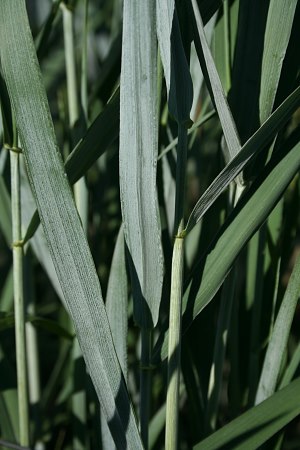
Description: During the late spring and summer, this native perennial grass is tufted at the base, producing unbranched culms about 3-5' tall. Each culm has about 8 alternate leaves that are distributed throughout its length; the lower leaves often become withered before commencement of the blooming period. From fall to spring, this grass produces clumps of low basal leaves up to 1' tall that are semi-evergreen. Each culm is light green, terete, and slightly glaucous; it is mostly hidden by the sheaths. The blades of the alternate leaves are up to 13" long and 2/3" (15 mm.) across; they are ascending to spreading, hairless, and widest toward the middle. The upper surface of each blade is green, while the lower surface is blue and glaucous. The sheaths of the alternate leaves are mostly blue and glaucous, although the lower sheaths may be somewhat green; they are hairless, open, and longer than than the internodal areas of the culm. Each ligule consists of a stiff short membrane that soon turns brown. The nodes of the culm are slightly swollen.

Each culm terminates in a nodding spike
about 5-9" long and 1½" across. This spike consists of a dense
arrangement of slightly spreading spikelets and their awns; it has a blue and a
glaucous appearance. Each spikelet has a pair of glumes below and 3-6 lemmas
above, forming a V-shape; the spikelets occur in groups of 2 or more. Each
glume is about 2.0–2.5 cm. long (including its awn) and 1.25 mm. across;
it is blue-glaucous, linear in shape, and slightly ciliate along the margins
with short stiff hairs. Each lemma is about 1.0–1.5 cm. long (excluding
its awn), 2.25 mm. across, and having an awn about 2.0–4.0 cm. long; it is
blue-glaucous, finely pubescent on the outer surface, and narrowly
linear-lanceolate in shape. Each lemma encloses a palea (a membrane that
surrounds the ovary/grain) that is 8.5–13.0 mm. in length. The blooming
period occurs during mid- to late summer. The culms and their spikes turn tan
during the fall, at which time the awns curve outward. Disarticulation of the
spikelets is above the glumes. The large grains are 5.0–7.0 mm. long,
1.5–2.0 mm. across, somewhat flattened, and narrowly oblongoid-ellipsoid
in shape. The root system is fibrous.
Cultivation: The preference is full to partial sun
and moist to dry conditions. This grass will adapt to practically any kind of
soil, including those containing loam, clay, gravel, or sand. This robust grass
readily reseeds itself and can be aggressive in some situations. If the seeds
are planted during the spring, it can develop culms with flowering spikes
during the summer or fall of the same year.
